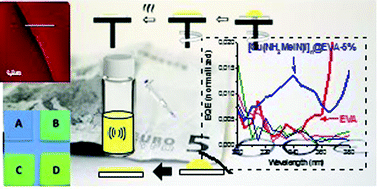当前位置:
X-MOL 学术
›
Dalton Trans.
›
论文详情
Our official English website, www.x-mol.net, welcomes your feedback! (Note: you will need to create a separate account there.)
Cu(I)–I coordination polymers as the possible substitutes of lanthanides as downshifters for increasing the conversion efficiency of solar cells
Dalton Transactions ( IF 4 ) Pub Date : 2020/02/26 , DOI: 10.1039/d0dt00356e Jesús López-Molina 1, 2, 3, 4 , Cecilio Hernández-Rodríguez 4, 5, 6, 7 , Ricardo Guerrero-Lemus 4, 5, 6, 7 , Eugenio Cantelar 1, 3, 4, 8 , Ginés Lifante 1, 3, 4, 8 , Marta Muñoz 4, 9, 10, 11 , Pilar Amo-Ochoa 1, 2, 3, 4, 12
Dalton Transactions ( IF 4 ) Pub Date : 2020/02/26 , DOI: 10.1039/d0dt00356e Jesús López-Molina 1, 2, 3, 4 , Cecilio Hernández-Rodríguez 4, 5, 6, 7 , Ricardo Guerrero-Lemus 4, 5, 6, 7 , Eugenio Cantelar 1, 3, 4, 8 , Ginés Lifante 1, 3, 4, 8 , Marta Muñoz 4, 9, 10, 11 , Pilar Amo-Ochoa 1, 2, 3, 4, 12
Affiliation

|
This study tries to provide new solutions to increase the efficiency of conversion of photons in solar cells, using photoluminescent Cu(I) coordination polymers (CPs) as possible alternative materials of lower cost, than those used today, based on lanthanides. The selected CP of chemical formula [Cu(NH2MeIN)I]n (NH2MeIN = methyl, 2-amino isonicotinate) absorbs in the utraviolet and emits in the visible region, being also easily nanoprocessable, by a simple and one-pot bottom-up approach. Nanofibers of this CP can be embedded in organic matrices such as ethyl vinyl acetate (EVA), forming transparent and homogenous films, with a thermal stability of up to approximately 150 °C. These new materials maintain the optical properties of the CP used as a dopant, ([Cu(NH2MeIN)I]n), with emission in yellow (570 nm) at 300 K, which is intensified when the working temperature is lowered. In addition, these materials can be prepared with varying thicknesses, from a few microns to a few hundred nanometers, depending on the deposition method used (drop casting or spin coating respectively). The study of their external quantum efficiency (EQE) found an increase in the UV range, which translates into an increase in the conversion efficiency. The optimal CP concentration is 5% by weight in order to not diminish the transparency of the composite material. The calculated cost on the possible incorporation of this material into solar cells shows a 50% decrease over the cost reported in similar studies based on the use of lanthanides.
中文翻译:

Cu(I)-I配位聚合物可以作为镧系元素的降档剂,以提高太阳能电池的转换效率
这项研究试图提供新的解决方案,以使用光致发光的Cu(I)配位聚合物(CP)作为可能的低成本替代材料,以提高太阳能电池中光子的转换效率,这种材料比目前使用的基于镧系元素的材料便宜。化学式[Cu(NH 2 MeIN)I] n(NH 2MeIN = 2-氨基异烟酸甲酯)在紫外线中吸收并在可见光区域发射,并且通过简单的一锅法自底向上方法也可以轻松地进行纳米加工。该CP的纳米纤维可以嵌入到有机基质中,例如乙基醋酸乙烯酯(EVA),形成透明且均匀的薄膜,热稳定性最高可达150°C。这些新材料保持了用作掺杂剂的CP([[Cu(NH 2 MeIN)I] n),在300 K时呈黄色(570 nm)发射,当降低工作温度时会增强。另外,根据所使用的沉积方法(分别为滴铸或旋涂),可以制备具有几微米至几百纳米的不同厚度的这些材料。对它们的外部量子效率(EQE)的研究发现,紫外线范围增加,这转化为转化效率的增加。为了不降低复合材料的透明度,最佳CP浓度为5重量%。将该材料可能掺入太阳能电池的计算成本显示,与基于镧系元素使用的类似研究报告的成本相比降低了50%。
更新日期:2020-04-08
中文翻译:

Cu(I)-I配位聚合物可以作为镧系元素的降档剂,以提高太阳能电池的转换效率
这项研究试图提供新的解决方案,以使用光致发光的Cu(I)配位聚合物(CP)作为可能的低成本替代材料,以提高太阳能电池中光子的转换效率,这种材料比目前使用的基于镧系元素的材料便宜。化学式[Cu(NH 2 MeIN)I] n(NH 2MeIN = 2-氨基异烟酸甲酯)在紫外线中吸收并在可见光区域发射,并且通过简单的一锅法自底向上方法也可以轻松地进行纳米加工。该CP的纳米纤维可以嵌入到有机基质中,例如乙基醋酸乙烯酯(EVA),形成透明且均匀的薄膜,热稳定性最高可达150°C。这些新材料保持了用作掺杂剂的CP([[Cu(NH 2 MeIN)I] n),在300 K时呈黄色(570 nm)发射,当降低工作温度时会增强。另外,根据所使用的沉积方法(分别为滴铸或旋涂),可以制备具有几微米至几百纳米的不同厚度的这些材料。对它们的外部量子效率(EQE)的研究发现,紫外线范围增加,这转化为转化效率的增加。为了不降低复合材料的透明度,最佳CP浓度为5重量%。将该材料可能掺入太阳能电池的计算成本显示,与基于镧系元素使用的类似研究报告的成本相比降低了50%。



























 京公网安备 11010802027423号
京公网安备 11010802027423号